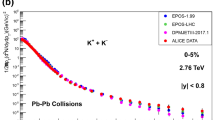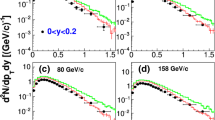Abstract
The present study aimed to explore the behavior of unpolarized fragmentation functions (FFs) of pion in the regions of small momentum fractions z. This study used a novel phenomenological QCD approach in the framework of fractal (or self-similar) behavior of FFs to quantify the small-z region. To this end, a simple parameterization for the pion fractal FFs is considered and small z experimental datasets on single inclusive pion production in electron–positron (\(e^+e^-\)) annihilation (SIA) for the range of \(10.54< Q < 91.28\) GeV and \(z<0.1\) are included in this analysis. The estimations of the uncertainty in the present analysis are carried out using the standard “Hessian” approach. In total, considering the overall value of \(\chi ^2/\mathrm{dof}\) and theory/data comparisons, the results indicate excellent agreements between the experimental datasets and the theory predictions at small momentum fractions z. Finally, we present detailed comparisons between predictions for the relevant small-z observables obtained with various recent models of pion FFs available in literature. Considering the findings presented in this study, we discuss how our knowledge of pion FFs may be improved at small-z by future measurements.










Similar content being viewed by others
Data Availability Statement
This manuscript has no associated data or the data will not be deposited [Authors’ comment: There is no data or why the data will not be deposited because all data that used in our paper are cited properly.]
References
H. Mäntysaari, B. Schenke, C. Shen, P. Tribedy, Proton structure fluctuations: constraints from HERA and applications to \(p+A\) collisions. Nucl. Phys. A 967, 317 (2017). arXiv:1705.03735 [nucl-th]
J. Gao, L. Harland-Lang, J. Rojo, The structure of the proton in the LHC precision era. Phys. Rep. 742, 1 (2018). arXiv:1709.04922 [hep-ph]
L. Rottoli, Precision QCD at the LHC: from the structure of the proton to all-order resummations, arXiv:1810.08257 [hep-ph]
E.C. Aschenauer, S. Fazio, M.A.C. Lamont, H. Paukkunen, P. Zurita, Nuclear structure functions at a future electron-ion collider. Phys. Rev. D 96(11), 114005 (2017). arXiv:1708.05654 [nucl-ex]
V. Bertone et al. [NNPDF Collaboration], A determination of the fragmentation functions of pions, kaons, and protons with faithful uncertainties. Eur. Phys. J. C 77(8), 516 (2017), arXiv:1706.07049 [hep-ph]
D. de Florian, R. Sassot, M. Epele, R.J. Hernández-Pinto, M. Stratmann, Parton-to-pion fragmentation reloaded. Phys. Rev. D 91(1), 014035 (2015). arXiv:1410.6027 [hep-ph]
D. de Florian, M. Epele, R.J. Hernandez-Pinto, R. Sassot, M. Stratmann, Parton-to-kaon fragmentation revisited. Phys. Rev. D 95(9), 094019 (2017). arXiv:1702.06353 [hep-ph]
D.P. Anderle, F. Ringer, M. Stratmann, Fragmentation functions at next-to-next-to-leading order accuracy. Phys. Rev. D 92(11), 114017 (2015). arXiv:1510.05845 [hep-ph]
V.N. Gribov, L.N. Lipatov, \(e^+ e^-\) pair annihilation and deep inelastic ep scattering in perturbation theory. Sov. J. Nucl. Phys. 15, 675 (1972). [Yad. Fiz. 15, 1218 (1972)]
G. Altarelli, G. Parisi, Asymptotic freedom in parton language. Nucl. Phys. B 126, 298 (1977)
A. Abada et al. [FCC Collaboration], FCC Physics opportunities: future circular collider conceptual design report volume 1. Eur. Phys. J. C 79(6), 474 (2019)
J.L. Abelleira Fernandez et al. [LHeC Study Group], A large hadron electron collider at CERN: report on the physics and design concepts for machine and detector. J. Phys. G 39, 075001 (2012), arXiv:1206.2913 [physics.acc-ph]
R. Abdul Khalek, S. Bailey, J. Gao, L. Harland-Lang and J. Rojo, Probing proton structure at the large hadron electron collider. arXiv:1906.10127 [hep-ph]
P. Azzi et al. [HL-LHC Collaboration and HE-LHC Working Group], Standard model physics at the HL-LHC and HE-LHC. arXiv:1902.04070 [hep-ph]
M. Soleymaninia, M. Goharipour, H. Khanpour, Impact of unidentified light charged hadron data on the determination of pion fragmentation functions. Phys. Rev. D 99(3), 034024 (2019). arXiv:1901.01120 [hep-ph]
N. Sato, J.J. Ethier, W. Melnitchouk, M. Hirai, S. Kumano, A. Accardi, First Monte Carlo analysis of fragmentation functions from single-inclusive \(e^+ e^-\) annihilation. Phys. Rev. D 94(11), 114004 (2016). arXiv:1609.00899 [hep-ph]
M. Hirai, S. Kumano, T.-H. Nagai, K. Sudoh, Determination of fragmentation functions and their uncertainties. Phys. Rev. D 75, 094009 (2007). arXiv:hep-ph/0702250
M. Soleymaninia, M. Goharipour, H. Khanpour, First QCD analysis of charged hadron fragmentation functions and their uncertainties at next-to-next-to-leading order. Phys. Rev. D 98(7), 074002 (2018). arXiv:1805.04847 [hep-ph]
T. Lastovicka, Selfsimilar properties of the proton structure at low x. Eur. Phys. J. C 24, 529 (2002). arXiv:hep-ph/0203260
A. Jahan, D.K. Choudhury, Self-similarity and the Froissart bound. Phys. Rev. D 89(1), 014014 (2014). arXiv:1401.4327 [hep-ph]
J.L. Albacete, J.G. Milhano, P. Quiroga-Arias, J. Rojo, Linear vs non-linear QCD evolution: from HERA data to LHC phenomenology. Eur. Phys. J. C 72, 2131 (2012). arXiv:1203.1043 [hep-ph]
P.J. Rijken, W.L. van Neerven, O (alpha-s**2) contributions to the asymmetric fragmentation function in e+ e- annihilation. Phys. Lett. B 392, 207 (1997). arXiv:hep-ph/9609379
J. Blumlein, V. Ravindran, O (alpha**2(s)) Timelike Wilson coefficients for parton-fragmentation functions in Mellin space. Nucl. Phys. B 749, 1 (2006). arXiv:hep-ph/0604019
A. Mitov, S.O. Moch, QCD corrections to semi-inclusive hadron production in electron–positron annihilation at two loops. Nucl. Phys. B 751, 18 (2006). arXiv:hep-ph/0604160
V.N. Gribov, L.N. Lipatov, Deep inelastic ep scattering in perturbation theory. Sov. J. Nucl. Phys. 15, 438 (1972). [Yad. Fiz. 15, 781 (1972)]
L.N. Lipatov, The parton model and perturbation theory. Sov. J. Nucl. Phys. 20, 94 (1975). [Yad. Fiz. 20, 181 (1974)]
Y.L. Dokshitzer, Calculation of the structure functions for deep inelastic scattering and e+ e- annihilation by perturbation theory in quantum chromodynamics. Sov. Phys. JETP 46, 641 (1977). [Zh. Eksp. Teor. Fiz. 73, 1216 (1977)]
A. Mitov, S. Moch, A. Vogt, Next-to-next-to-leading order evolution of non-singlet fragmentation functions. Phys. Lett. B 638, 61 (2006). arXiv:hep-ph/0604053
S. Moch, A. Vogt, On third-order timelike splitting functions and top-mediated Higgs decay into hadrons. Phys. Lett. B 659, 290 (2008). arXiv:0709.3899 [hep-ph]
A.A. Almasy, S. Moch, A. Vogt, On the next-to-next-to-leading order evolution of flavour-singlet fragmentation functions. Nucl. Phys. B 854, 133 (2012). arXiv:1107.2263 [hep-ph]
V. Bertone, S. Carrazza, J. Rojo, APFEL: a PDF evolution library with QED corrections. Comput. Phys. Commun. 185, 1647 (2014). arXiv:1310.1394 [hep-ph]
T. Lastovicka, Measurement of the inclusive deep inelastic scattering cross section at low \(Q^2\). https://doi.org/10.3204/DESY-THESIS-2004-016
D. de Florian, R. Sassot, M. Stratmann, Global analysis of fragmentation functions for protons and charged hadrons. Phys. Rev. D 76, 074033 (2007). arXiv:0707.1506 [hep-ph]
D.P. Anderle, T. Kaufmann, M. Stratmann, F. Ringer, Phys. Rev. D 95(5), 054003 (2017). https://doi.org/10.1103/PhysRevD.95.054003. arXiv:1611.03371 [hep-ph]
A. Vogt, JHEP 1110, 025 (2011). https://doi.org/10.1007/JHEP10(2011)025. arXiv:1108.2993 [hep-ph]. [36]
C.-H. Kom, A. Vogt, K. Yeats, JHEP 1210, 033 (2012). https://doi.org/10.1007/JHEP10(2012)033. arXiv:1207.5631 [hep-ph]
D. Buskulic et al. [ALEPH Collaboration], Inclusive pi+-, K+- and (p, anti-p) differential cross-sections at the Z resonance. Z. Phys. C 66, 355 (1995)
P. Abreu et al. [DELPHI Collaboration], pi+-, K+-, p and anti-p production in Z0 –\(>\) q anti-q, Z0 –\(>\) b anti-b, Z0 –\(>\) u anti-u, d anti-d, s anti-s. Eur. Phys. J. C 5, 585 (1998)
R. Akers et al. [OPAL Collaboration], Measurement of the production rates of charged hadrons in e+ e- annihilation at the Z0. Z. Phys. C 63, 181 (1994)
R. Brandelik et al. [TASSO Collaboration], Charged pion, kaon, proton and anti-proton production in high-energy e+ e- annihilation. Phys. Lett. 94B, 444 (1980)
M. Althoff et al., [TASSO Collaboration], Charged hadron composition of the final state in e+ e- annihilation at high-energies. Z. Phys. C 17, 5 (1983)
W. Braunschweig et al. [TASSO Collaboration], Pion, kaon and proton cross-sections in \(e^+ e^-\) annihilation at 34-GeV and 44-GeV center-of-mass energy. Z. Phys. C 42, 189 (1989)
J. P. Lees et al. [BaBar Collaboration], Production of charged pions, kaons, and protons in \(e^+e^-\) annihilations into hadrons at \(\sqrt{s}=10.54\) GeV. Phys. Rev. D 88, 032011 (2013), arXiv:1306.2895 [hep-ex]
H. Aihara et al. [TPC/Two Gamma Collaboration], Charged hadron inclusive cross-sections and fractions in \(e^+e^-\) annihiliation \(\sqrt{s}=29\) GeV. Phys. Rev. Lett. 61, 1263 (1988)
K. Abe et al. [SLD Collaboration], Production of pi+, pi-, K+, K-, p and anti-p in light (uds), c and b jets from Z0 decays. Phys. Rev. D 69, 072003 (2004). arXiv:hep-ex/0310017
H. Khanpour, S.A. Tehrani, Global analysis of nuclear parton distribution functions and their uncertainties at next-to-next-to-leading order. Phys. Rev. D 93(1), 014026 (2016). arXiv:1601.00939 [hep-ph]
A.D. Martin, W.J. Stirling, R.S. Thorne, G. Watt, Parton distributions for the LHC. Eur. Phys. J. C 63, 189 (2009). arXiv:0901.0002 [hep-ph]
F. James, “MINUIT Function Minimization and Error Analysis: Reference Manual Version 94.1,” CERN-D-506, CERN-D506, F. James and M. Roos, “Minuit: A System for Function Minimization and Analysis of the Parameter Errors and Correlations”. Comput. Phys. Commun. 10, 343 (1975). https://doi.org/10.1016/0010-4655(75)90039-9
T.J. Hou et al., Reconstruction of Monte Carlo replicas from Hessian parton distributions. JHEP 1703, 099 (2017). arXiv:1607.06066 [hep-ph]
J. Pumplin, D. Stump, R. Brock, D. Casey, J. Huston, J. Kalk, H.L. Lai, W.K. Tung, Uncertainties of predictions from parton distribution functions. 2. The Hessian method. Phys. Rev. D 65, 014013 (2001). arXiv:hep-ph/0101032
A.D. Martin, R.G. Roberts, W.J. Stirling, R.S. Thorne, Uncertainties of predictions from parton distributions. 1: Experimental errors. Eur. Phys. J. C 28, 455 (2003). arXiv:hep-ph/0211080
H. Khanpour, Phenomenology of diffractive DIS in the framework of fracture functions and determination of diffractive parton distribution functions. Phys. Rev. D 99(5), 054007 (2019). arXiv:1902.10734 [hep-ph]
T. Kneesch, B.A. Kniehl, G. Kramer, I. Schienbein, Charmed-meson fragmentation functions with finite-mass corrections. Nucl. Phys. B 799, 34 (2008). arXiv:0712.0481 [hep-ph]
SM Moosavi Nejad, M. Soleymaninia, A. Maktoubian, Proton fragmentation functions considering finite-mass corrections. Eur. Phys. J. A 52(10), 316 (2016). arXiv:1512.01855 [hep-ph]
M. Salajegheh, S.M. Moosavi Nejad, M. Soleymaninia, H. Khanpour, S. Atashbar Tehrani, NNLO charmed-meson fragmentation functions and their uncertainties in the presence of meson mass corrections. arXiv:1904.09832 [hep-ph]
S. Albino, B.A. Kniehl, G. Kramer, AKK update: improvements from new theoretical input and experimental data. Nucl. Phys. B 803, 42 (2008). arXiv:0803.2768 [hep-ph]
Acknowledgements
Authors are thankful to Maryam Soleymaninia and Hamzeh Khanpour for many helpful discussions and comments. F. Taghavi-Shahri is grateful Ferdowsi University of Mashhad for financial support for this project. This work is supported by Ferdowsi University of Mashhad under Grant no. 3/46985.
Author information
Authors and Affiliations
Corresponding author
Additional information
Communicated by Reinhard Alkofer
Rights and permissions
About this article
Cite this article
Mohamaditabar, A., Taghavi-Shahri, F. & Shoeibi, S. Towards small-z fragmentation functions of pion from QCD analysis of single-inclusive electron–positron annihilation. Eur. Phys. J. A 56, 77 (2020). https://doi.org/10.1140/epja/s10050-020-00087-y
Received:
Accepted:
Published:
DOI: https://doi.org/10.1140/epja/s10050-020-00087-y




